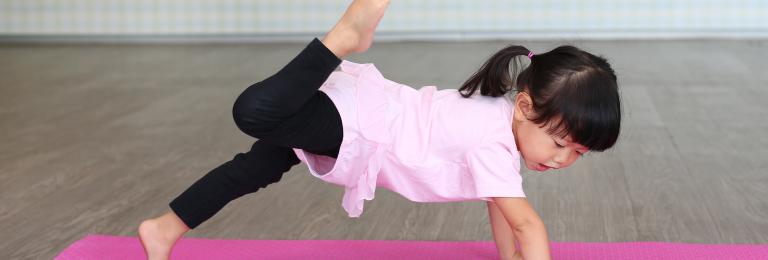Yoga poses
Developing movement skills (body awareness and manipulation, balance)
- Invite the children to find their own space in the room.
- Move through a variety of yoga poses that are safe and fun for kids.
Breathing (Pranayama)
Every yoga class begins with a few quiet minutes to prepare the body and mind for the practice. Breathing helps our minds and bodies relax. Tell the children: “Let’s sit in a comfortable position. Close your eyes. Slowly, breathe in through your nose (pause), and out through your nose (pause). Breathe in through your nose (pause), and out through your nose (pause). Feel your body and mind getting ready for yoga. Slowly open your eyes.”
Downward Facing Dog Pose (Adho Mukha Svanasana)
This pose helps build strong muscles, flexibility of the joints and spine, and confidence in our body’s ability to move in unique ways. Tell the children: “Let’s do the dog pose together.” (Begin in an all fours position, (hands under shoulders, and knees under hips. Curl your toes under; straighten your legs and then your arms. Hold this upside down V position for three breaths. Carefully return to all fours). Ask the children, “How does your body feel?”
Child’s Pose
Tell the children: “Let’s do the child’s pose together.” (Sit on your heels, lower your forehead to the ground and extend your arms way out in front of you.) Ask the children, “Did you feel your knees pushing on your belly? This pose helps your belly digest food better.”
Vinyasas
These are sequences of yoga poses, done without stopping. Vinyasas make our hearts beat faster which strengthens the heart muscle and gives us energy. Tell the children: “Let’s put our downward facing dog and child’s poses together.” (Begin with the dog pose, lower to all fours and move into the child’s pose, return to all fours and then the dog pose, back to all fours and the child’s pose. Rest here.) Ask the children, “Do you feel your heart beating faster? It’s getting stronger!”
Tree Pose (Vrksasana)
Balancing poses, like the tree, improve our ability to focus, pay attention, and concentrate for longer and longer periods of time. Tell the children: “Imagine you are a tall tree with roots growing out the bottoms of your feet. Let’s do the tree balance together. (Begin in a standing position with palms touching and thumbs resting on your heart). Shift your weight to your left leg and slowly raise your right foot to your ankle, shin, or inner thigh with your knee facing out. Slowly return your foot to the floor and repeat on the other side.) Ask the children, “Was one side easier than the other? Balancing poses take practice and you will get better and better!”
Relaxation Pose (Shavasana)
This special pose is done at the end of every yoga class, but can be done anytime of the day or night to help us relax. Tell the children: “Let’s do the relaxation pose together.” (Lie on your backs, palms at your sides facing up, legs fall off to the sides). “Close your eyes. Focus on your breath moving in and out of your nose. Feel your belly rising and falling.” (To help children relax in this pose, play soft music and dim the lights). Ask the children, “How do you feel?”
Namaste
After the relaxation pose, it is traditional to return to a sitting position, bring your palms together with thumbs touching your heart, and making eye contact and smiling with each other, saying the word, “Namaste.” Namaste is a Sanskrit word that means, “the light in you sees the light in me” or more simply, “we are all special.” This simple greeting teaches all of us about respect.
Adapted from PBS Kids
